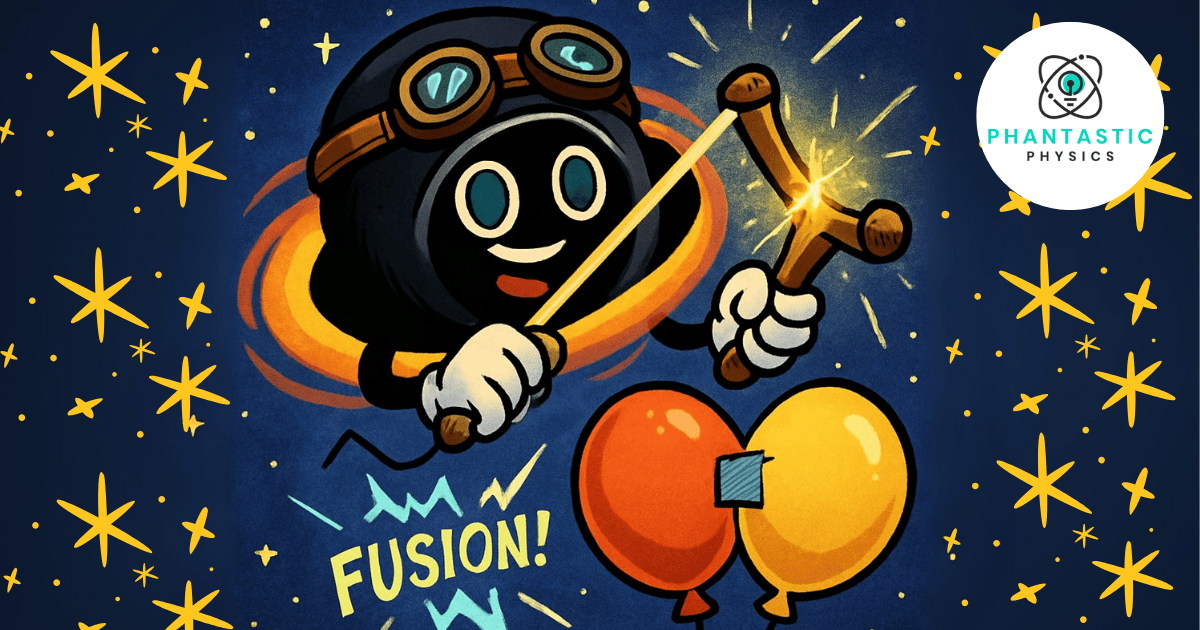- Phantastic Physics
- Posts
- The Physics Secret That Turns Black Holes into Cosmic Supercolliders
The Physics Secret That Turns Black Holes into Cosmic Supercolliders
Plus: A forgotten 1938 fusion breakthrough that could power your phone with starlight and a 5-minute balloon demo that makes you the Sun’s stunt double...

Hey there, Physics Friend!
Ever stared at your phone’s GPS and thought, “Yeah, it’s okay… but could a quantum clock make it 1,000× better?”
This week we’re going full sci-fi: black holes acting like cosmic supercolliders, room-temperature masers powered by LEDs, and a 1938 fusion experiment that might just rewrite the future of clean energy. Buckle up—your brain’s about to hit relativistic speeds.
🌟 This Past Week's "Wait, WHAT?!" Physics News
🕳️ Black Holes Could Be Cosmic Supercolliders
Forget the LHC—black holes sling particles so fast they make CERN look like a kiddie ride. Extreme gravity = ultimate accelerator. Could explain cosmic rays and dark matter. Mind officially bent. Read more →
🌡️ Room-Temperature Maser Built with LEDs
Lasers got cool cousins: masers (microwave lasers). Scientists just made one that runs at room temp using LEDs. Translation: cheaper, better communication tech incoming. Read more →
❄️ Cold Atoms, Hot Physics
Using ultra-cold atoms to accelerate particles with way less energy. It’s like giving the early universe a chill pill while unlocking cosmic mysteries. Read more →
🔥 1938 Fusion Experiment Recreated—History May Be Rewritten
Researchers rebuilt a forgotten 1938 fusion setup. Results? We might have been wrong about how stars—and future reactors—really cook up energy. Read more →
⏱️ Quantum Clocks vs. GPS
Naval tests show quantum clocks crush GPS accuracy by orders of magnitude. Imagine never missing a turn or a satellite again. Read more →
💡 Light Acts Like a Spinning Fluid
Scientists watched light swirl like a two-component fluid. Think optical tornadoes—could revolutionize future photonic devices. Read more
Astronomers just captured the first-ever image of a star that exploded not once, but TWICE. It's like the universe's ultimate encore performance. This discovery is rewriting what we thought we knew about how stars die. Read more →
📚 Featured Article: Ready to Teach!
This week's most mind-blowing story has been rewritten for your students. Just print and go!
Cosmic Collisions & Black Hole Cannons
We rewrote the black-hole-supercollider story at a high-school level, plus five discussion questions that’ll launch your students into orbit (metaphorically).
Teaser: Did you know a black hole’s gravity alone can boost particles to 99.9% the speed of light?
🎬 Videos Your Students Will Actually Watch
Use this video to demonstrate projectile motion concepts in class.
Great for visualizing electromagnetic forces and induction.
Illustrate principles of gravity and friction through a fun race.
🎈Exploring Fusion with 'Balloon Nuclei'
The Setup: Turn your classroom into a star-core simulator in under 15 minutes!
You'll need:
2 balloons per group
Marker
Tape
(Optional) string & scissors
The "Whoa!" Moments:
Proton Push-Back
Inflate both balloons, draw a dot on each to mark the “nucleus.”
Have students slowly bring the balloons together—watch them repel like positively-charged protons!
The Great Smash
Now slam the balloons together and slap on a strip of tape—boom, instant “helium” fusion.
Cue the collective “Wait, that’s how the Sun works?!”
Energy Pop Quiz
Let the fused “helium” balloon float up—ask: Where did the energy come from?
Hint: the tape = the strong force that only kicks in when protons get really close.
Why It Works: Inside stars, hydrogen nuclei normally bounce apart. Only at 15 million °C do they slam hard enough for the strong force to glue them into helium, releasing the energy that keeps us all alive. Your tape does the gluing—no super-heated plasma required.
😄 Physics Laugh & Learn
Why did the black hole start a race? Because it wanted to say, ‘Hold my gravity! I’m about to accelerate some particles!’
Why this is actually genius: Black holes sound terrifying, but picture one as the ultimate drag-strip racer. Its gravitational pull is so insane that any particle daring to orbit gets slingshotted to 99.9 % the speed of light—no turbo boost required. The joke flips the script: instead of devouring everything, the black hole is just showing off its horsepower. Students instantly lock in the idea that extreme gravity = ultimate particle accelerator—and they’ll never look at empty space the same way again.
P.S. Got a physics joke, demo, or cosmic collision story? Hit reply—we read every email.
Stay Curious ✨
The Phantastic Physics Team
Quick Question: How useful was today's newsletter? |